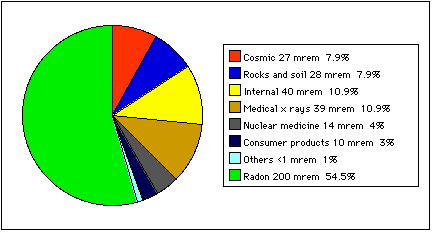For biologists, the most significant forms of radiation are light, heat, and ionizing radiation. Ionizing radiation can penetrate cells and create ions in the cell contents. These, in turn, can cause permanent alterations in DNA; that is, mutations.
Ionizing radiation includes:The rad represents a certain dose of energy absorbed by 1 gram of tissue. It is a unit of concentration. So if we could uniformly expose the entire body to radiation, the number of rads received would be the same whether we were speaking of a single cell, an organ (e.g., an ovary) or the entire body (just as the concentration of salt in sea water is the same whether we consider a cupful or an entire ocean).
Some forms of radiation are more efficient than others transferring their energy to the cell. To have a level playing field, it is convenient to multiply the dose in rads by a quality factor (Q) for each type of radiation. The resulting unit is the rem ("roentgen-equivalent man"). Thus, rem = rad x Q. X rays and gamma rays have a Q about 1, so the absorbed dose in rads is the same number in rems. Neutrons have a Q of about 5 and alpha particles have a Q of about 20. An absorbed dose of, say, 1 rad of these is equivalent to 5 rem and 20 rem respectively.
Despite the years of high-quality research reported in rems and millirems (mrem, 10-3 rem), the International Commission on Radiation Units and Measurements wants us to give up the rad in favor of the gray (Gy), a unit 100 times larger. Similarly, the rem is to be replaced by the sievert (Sv), again so that 100 rem = 1 Sv. Unfortunately, the rad and rem were already a little large to work with (why the table below is expressed in millirems) and converting to grays and sieverts makes the problem worse. Happily, many workers continue to use the rad and rem, and so shall we. In fact, I will try to express all radiation doses in a single unit the millirem.
| Approximate lethal dose (to the entire body in a short period) | 450,000 |
| Causes radiation sickness (when absorbed in a short period) | >100,000 |
| Increase in lifetime dose to most heavily exposed people living near Chernobyl | 43,000 |
| Average annual dose (excluding natural background) for medical x-ray technicians | 320 |
| Maximum permissible annual dose (excluding natural background and medical exposure) to general public | 170 |
| Natural background, Boston, MA, USA (per year)(excluding radon) | 102 |
| Natural background, Denver, CO, USA, (per year)(excluding radon) | 180 |
| Additional annual dose if you live in a brick rather than a wood house | 7 |
| Average dose to person living within 10 miles of Three-Mile Island (TMI) caused by the accident of 28 March 1979 | 8 |
| Most heavily exposed person (a fisherman) near TMI | <100 |
| Approximate dose received by a person spending 1 year at the fence surrounding a nuclear power station | 0.1 - 0.6 |
| Average dose to each person in the U. S. population from nuclear power plants (per year) | 0.002 |
| Received by the bone marrow during a set of dental x rays* | 9.4 |
| Annual dose to the gonads from TV sets | 0.2 - 1.5 |
| Received by the bone marrow during a barium enema | 875 |
| Received by the bone marrow during a chest x ray | 10 |
| Received by breast during mammogram | 50 - 700 |
| Average airline passenger (10 flights/year) | 3 |
| Flight crew and cabin attendants (per year) | 160 |
| Hourly dose to skin holding piece of the original "Fiesta Ware" (a brand of pottery) | 200 - 300 |
| Annual dose to each person in the U. S. population from fallout (former weapons testing plus Chernobyl) | 0.06 |
 Estimated average annual radiation exposure from various sources (in millirems) of an inhabitant of the United States. Individual exposures, especially to radon and medical sources, vary widely from these average values. Furthermore, only the lungs are exposed to radon doses; the alpha particles emitted by radon cannot penetrate other tissues. (Data from the National Council on Radiation Protection and Measurements, Bethesda, MD.)
Estimated average annual radiation exposure from various sources (in millirems) of an inhabitant of the United States. Individual exposures, especially to radon and medical sources, vary widely from these average values. Furthermore, only the lungs are exposed to radon doses; the alpha particles emitted by radon cannot penetrate other tissues. (Data from the National Council on Radiation Protection and Measurements, Bethesda, MD.)
| Welcome&Next Search |